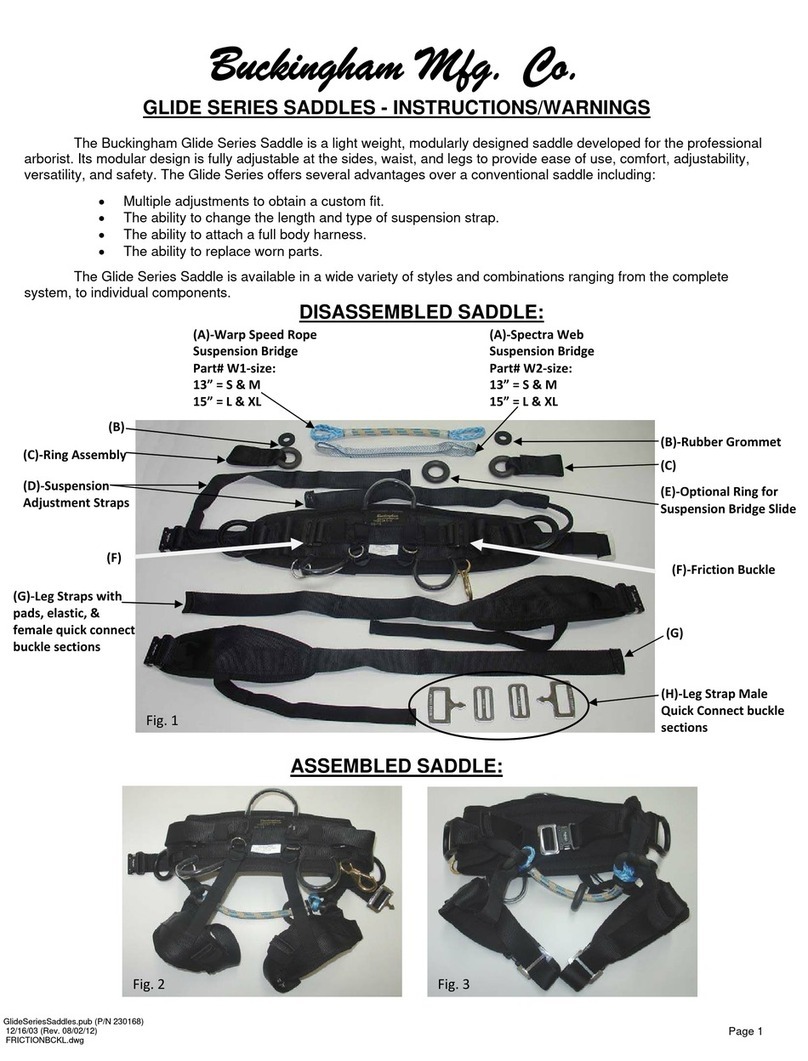
BYARDWARN.DOC 4/8/99 (Rev. 1-30-20) Page 2 of 4
P/N 230082
Should there be any question regarding the safety of any piece of personal protective equipment, we require that use be
immediately discontinued, and the product(s) involved be properly disposed of and replaced.
Product must not be altered in any way.
Only Buckingham Mfg. Co. or those people authorized in writing by Buckingham Mfg. Co. may make repairs to this equipment.
In the event of a fall, the employee must have a rescue plan and the means to implement it.
Never use an energy absorbing lanyard for positioning. Unit can open and extend, which could result in a fall.
OSHA requires that impact force in a fall NOT exceed an 1800 lbf. limit with a harness. Keep connecting device slack to a minimum to
stay under these limits.
Buckingham’s BuckYard (Energy Absorbing Lanyard) is equipped with an impact load indicator label that is designed to deploy upon
arresting a fall exposing this label making the text legible. If you can read the text, the Energy Absorbing Lanyard has been impact loaded.
If a fall occurs or any evidence of wear, deterioration or impact loading as outlined is observed, immediately cease use, destroy the product
and replace it with new equipment.
Always attach BuckYard to designated rear D-ring attachment of a personal fall arrest system.
If connecting to a personal fall arrest system by attaching directly through the web loop of the BuckYard carefully inspect the web loop to
ensue no cuts, kinks, abrasions, burns, excessive swelling, excessive wear discoloration, charring, broken fibers, loose
stitching and chemical or physical exposures exist.
Energy absorbing lanyards should be considered as a part of a personal fall arrest system used in conjunction with a harness.
Harnesses must be worn so the fall arrest attachment is centered in back near shoulder blade level. It is recommended that:
A connecting device and fall arrest attachment manufactured with a web loop be attached with a hitch or carabiner.
If using a locking snap hook to a web loop fall arrest attachment, the web loop must be protected by an integral wear piece to
enhance visual inspection
Web loop fall arrest attachments must be inspected before each use. The inspection should include, but not be limited to
ensuring no: webbing cuts, kinks, abrasions, burns, excessive swelling, excessive wear, discoloration, charring, broken fibers,
loose stitching and chemical or physical exposures exist.
Note: The use of a locking snaphook to a web loop fall arrest attachment without an integral wear piece is acceptable in emergency
situations (i.e. rescue, evacuation, etc.) Attachment of a locking snap hook to a web loop fall arrest attachment with no wear piece can
cause premature wear of the webbing and stitching. This degradation can cause the web loop layers to separate and be incapable of
supporting your weight. Therefore, the web loop fall arrest attachment must be inspected before use. Additionally, connections used to
attach to the fall arrest attachment must have a minimum gate rating of 3600 lbf. and meet ANSI Z359.12 requirements.
Fall arrest anchor points must support a minimum of 5,000 lbf (22.2 kN) per attached worker and be independent of worker support.
No fall protection system can guarantee that you will not sustain injuries should a fall occur. Therefore, BuckYards should be kept as
short as possible to minimize free fall distance. OSHA requires that maximum length of energy absorbing lanyards provide for a fall of no
greater than six (6) feet (1.8 m), allow no contact with any lower level and unit elongation not exceed 42" (1.07m).
The fall arrest attachment point on the user should be in the middle of the back near shoulder blade level.
When using a standard BuckYard, keep anchor point above rear fall arrest attachment. If climbing above anchor point, attach to a new
anchor point higher up. If anchor point above the fall arrest attachment device is not available, BuckYard positioning must be such that
free fall will be limited to a maximum of six (6’) feet (1.8 m) or the specified overall length of the BuckYard, whichever is less and such
that there will be no contact with a lower level. If anchor point is below fall arrest attachment a BuckYard with product number suffixed
with X12 be used. See Fig. 1 for calculating fall distance / clearance for both standard and X12 BuckYards.
FC = Fall Clearance / Distance
LL = Lanyard Length
EL = Elongation Length
UH = User’s Height
SF = Safety Factor (accounts for harness stretch)
Example: With a standard 6’ Lanyard with 4’ Elongation
Length used by a 6’ tall person.
FC = LL+ EL +UH+SF
FC = 6’+4’+6’+3’ = 19’
NOTE: The example shown below requires a special
energy absorbing lanyard. Lanyard product number
must be suffixed with X12.
Example: With a 6’ Lanyard (suffixed X12) with 5’ Elongation Length used by a 6’ tall person.
FC = LL+ EL +UH+SF
FC = 6’+5’+6’+3’ = 20’
Always work directly under fall arrest anchor point to avoid swing fall injuries (pendulum effect).
Never wrap a BuckYard around a beam, sharp structural member or abrasive surface, as the material could be cut or damaged.
Avoid contact of this equipment with high temperature surfaces, welding, or other heat sources, electrical hazards or moving machinery.
Avoid contact of this equipment with chemicals which may damage the material. If in doubt, contact supplier or Buckingham Mfg. Co.
Use PPE only for the specific purpose for which it is designed and intended.
Never use this product as a tie back type lanyard as the length will be shortened and result in altering its energy absorption / extension
properties.
OVER























